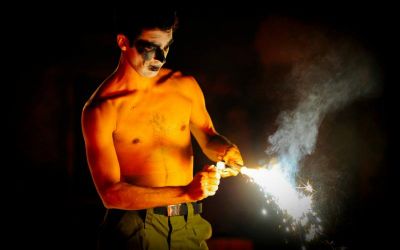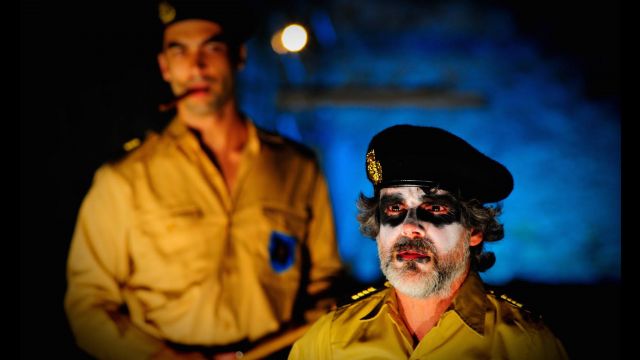Massacre
As we were ushered in, we were asked to take a seat near the centre perhaps so that the performers could direct the full intensity of this extraordinary piece directly at us, breaking the metaphorical fourth wall with glares straight into our souls—or at least, that was how it felt. Paulo Castro’s Massacre is blood-soaked poetry full of anger, resentment and accusation, with moments of quiet beauty and foreboding moving towards horror. This is not a straight retelling of the story and there is no realistic "massacre" as such. Instead, it's a surreal dreamscape with roots in Absurdist Theatre and performance art, taking the form of a progression of gothic images and stylised prose.
 The light palette is limited to blood red, stark white and a warm yellow-white which in other circumstances might provide some comfort, but here is harsh. Castro and Romão play characters East (Timor), Portugal, Indonesia and Australia. Through the play, we see East Timor ignored, exploited, abandoned and invaded. Every image is dark and beautiful: we see a dancing skeleton, a buried man, someone crushed by a book. The visual metaphor is wry or sarcastic, some of it clear in meaning, like Portugal requesting a sexual act of East Timor, and other images more ambiguous, like Portugal repeatedly failing to erect a cross at East Timor’s grave. The work drips with the bitterness, firstly at the world's (Australia's in particular) complicity in having ignored East Timor’s invasion by Indonesia, and then at the world's indifference after East Timor's since that time.
The light palette is limited to blood red, stark white and a warm yellow-white which in other circumstances might provide some comfort, but here is harsh. Castro and Romão play characters East (Timor), Portugal, Indonesia and Australia. Through the play, we see East Timor ignored, exploited, abandoned and invaded. Every image is dark and beautiful: we see a dancing skeleton, a buried man, someone crushed by a book. The visual metaphor is wry or sarcastic, some of it clear in meaning, like Portugal requesting a sexual act of East Timor, and other images more ambiguous, like Portugal repeatedly failing to erect a cross at East Timor’s grave. The work drips with the bitterness, firstly at the world's (Australia's in particular) complicity in having ignored East Timor’s invasion by Indonesia, and then at the world's indifference after East Timor's since that time.
 The use of props as an element of the sound design is clever, allowing tiles to scrape against each other and planks of wood to clatter. They’ve made interesting use of contrasts: violent heavy metal is punctuated with times of near silence, stillness with dance, and stylised poetic sections with more naturalistic speech. From the beginning, the finale of the title is foreshadowed, giving a sense of unease that builds to horror as the play moves forward.
The use of props as an element of the sound design is clever, allowing tiles to scrape against each other and planks of wood to clatter. They’ve made interesting use of contrasts: violent heavy metal is punctuated with times of near silence, stillness with dance, and stylised poetic sections with more naturalistic speech. From the beginning, the finale of the title is foreshadowed, giving a sense of unease that builds to horror as the play moves forward.
Altogether this makes for a powerful experience. You will not learn about the history of East Timor here; instead you will come away understanding the author’s feelings of trauma and betrayal in response to that tragedy. Heavy strobe and mild nudity makes this show unsuitable for epileptics or children (parental discretion advised).
Cathy Bannister
Images by Susana Paiva
Subscribe to our E-Newsletter, buy our latest print edition or find a Performing Arts book at Book Nook.

